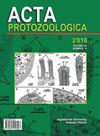On Papulifères, putative ciliate cysts of diverse morphologies, with new observations from the plankton of the Chukchi Sea (Arctic Ocean)
IF 1.2
4区 生物学
Q4 MICROBIOLOGY
引用次数: 0
Abstract
In the early 20th century, Alphonse Meunier described "Papulifères" as a group of enigmatic forms of unknown taxonomic affinity characterized by possessing a hyaline pimple, a "papula". In the early 1980's Papulifères were equated with cysts of tintinnid ciliates. The most conspicuous forms, the large Fusopsis, have been widely found, and are now known to resemble the cyst of a certain species of oligotrich ciliate (i.e., Cyrtostrombidium boreale). Thus today, Papulifère forms are often assumed to be cysts of oligotrich ciliates. Here we report on 26 Papulifère forms, of more or less distinct morphologies, found in the plankton of the Chukchi Sea. We found forms resembling some of those described by Meunier, and recorded here for the first time since Meunier's reports, and others that do not resemble any of Meunier's Papulifères. Here, we first review the literature on Papulifères, then we present the surprising variety of forms we found in Chukchi Sea, and for some, we provide for the first time data on morphological variability. With this report we have expanded the catalogue of observed Papulifère forms and documented variability in the dimensions of some morphotypes. However, we urge caution in assigning a ciliate species name to any given Papulifère form in the absence of corroborating data. There is a need for observational and/or sequence-based data to elucidate the identity of Papulifère forms.基于楚科奇海(北冰洋)浮游生物新观测的多种形态的假定纤毛虫囊
在20世纪初,Alphonse Meunier将“papulif”描述为一组未知分类亲和力的神秘形式,其特征是具有透明的丘疹,即“丘疹”。在20世纪80年代早期,巴布亚绒毛病被认为是栉状纤毛虫的囊肿。最明显的形式,大Fusopsis,已经被广泛发现,现在已知类似于某种低营养纤毛虫(即Cyrtostrombidium boreale)的囊肿。因此,今天,papullif的形式通常被认为是低营养纤毛虫的囊肿。在这里,我们报告了在楚科奇海浮游生物中发现的26种或多或少形态不同的papulif形式。我们发现了一些类似于莫尼耶所描述的形式,这是自莫尼耶的报告以来第一次在这里记录,还有一些不像莫尼耶的papullif的形式。在这里,我们首先回顾了关于巴布亚生物的文献,然后我们展示了我们在楚科奇海发现的令人惊讶的各种形式,并且我们首次提供了一些形态变异的数据。在本报告中,我们扩大了观察到的papullif形式的目录,并记录了某些形态的尺寸变化。然而,我们敦促在没有确凿数据的情况下,对任何给定的papulif形态分配纤毛虫物种名称时要谨慎。需要观察和/或基于序列的数据来阐明papulif形式的特性。
本文章由计算机程序翻译,如有差异,请以英文原文为准。
求助全文
约1分钟内获得全文
求助全文
来源期刊

Acta Protozoologica
生物-微生物学
CiteScore
2.00
自引率
0.00%
发文量
8
审稿时长
>12 weeks
期刊介绍:
Acta Protozoologica - International Journal on Protistology - is a quarterly journal that publishes current and comprehensive, experimental, and theoretical contributions across the breadth of protistology, and cell biology of Eukaryote microorganisms including: behaviour, biochemistry and molecular biology, development, ecology, genetics, parasitology, physiology, photobiology, systematics and phylogeny, and ultrastructure. It publishes original research reports, critical reviews of current research written by invited experts in the field, short communications, book reviews, and letters to the Editor.
 求助内容:
求助内容: 应助结果提醒方式:
应助结果提醒方式:


